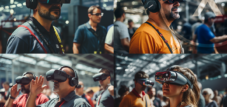
Hybrid trade fairs: Planning and organization of hybrid trade fairs (Virtual & Reality) – Image: Xpert.Digital
The mainstay trade fair relies on virtual solutions
Trade shows are a traditional marketing strategy used by companies to showcase their latest products and connect with other businesses, customers, and potential partners within their industry. By participating in event marketing formats like trade shows, many companies aim to increase brand awareness and boost sales. Other common marketing objectives include fostering customer loyalty, improving product knowledge, and launching new products. Although trade shows and other in-person promotional events have faced stiff competition from digital marketing channels in recent years, they remain among the most profitable business-to-business (B2B) media strategies worldwide. In 2019, the global B2B trade show market was valued at US$34.4 billion, and this figure is expected to exceed US$40 billion by 2023.
Interestingly, while the trade show industry is largest in the United States, the biggest trade show organizers tend to be European companies. A significant number of trade shows worldwide take place in the United States. In 2019, the US trade show industry generated over $15.7 billion in revenue, accounting for almost half of the total global revenue. In terms of sales, almost half of the revenue from US trade shows comes from registrations, and another quarter from the sale of exhibits.
Thanks to digital innovations, immersive offerings, and a general focus on entertainment, the US trade show industry has seen annual revenue growth for several decades . Given that trade shows were often considered outdated in the past, these developments have certainly helped to revitalize this marketing format and transform traditional networking events into unique experiences.
Depending on the event, the number of exhibitors at major US trade shows has either remained stable or increased in recent years. When asked about attendance figures for 2019, few industry experts reported a decline in exhibitor and visitor numbers at US conventions. Although reaching target audiences was cited as the biggest challenge in increasing trade show attendance, the majority of exhibitors expressed confidence in their future trade show results for 2019, and this optimism was reflected in their marketing budgets.
Due to the outbreak of the coronavirus (COVID-19), marketers and exhibitors in the United States were forced to rethink their budgets and revenue forecasts at the beginning of 2020. Around 66 percent of the US event organizers surveyed decided to postpone trade shows and conventions in light of the pandemic. In comparison, around 87 percent of organizers canceled their events altogether.
In order to recover from the radical decline in trade fair visitor numbers and revenues in the first quarter of 2020, many industry representatives have shifted their event budgets to digital channels and started holding virtual events.
It remains to be seen when and how visitors will be able to participate in trade fairs in person again, as the future of the exhibition, congress and conference industry is still uncertain – in the United States and worldwide.
Marketing for trade fair events
According to a study from June 2021, the impact of the coronavirus pandemic (COVID-19) was the most important issue for the global trade fair industry. Around 29 percent of respondents cited the pandemic as their main problem, a figure unchanged from December 2020. Economic issues followed in second and third place: 19 percent of respondents named the economy in their home market and 15 percent the global economic situation as the second and third most important problems for the industry, respectively.
The trade fair industry
The trade fair industry is a fairly broad term encompassing all organized events for the presentation or exhibition of a selection of objects. At one end of the spectrum are public exhibitions of art or history in a gallery or museum, and at the other end are trade fairs where goods and services of a particular industry are presented only to invited guests. Despite the differences, both sides of the industry are business-oriented – the most popular art exhibitions can attract more than a million visitors, while the trade fair industry generated over US$30 billion in revenue worldwide in 2016.
Measure
In many ways, the challenges facing the trade show industry are more complex than those for art and history exhibitions, as the range of exhibits for the latter is limited. Technological developments such as digital advertising and social media may reduce the need for physical trade shows to raise product awareness—although these two aspects are not mutually exclusive, as the internet can also be used to promote exhibitions. The personal nature of trade shows also offers a unique networking opportunity. Interestingly, while the trade show industry is largest in the United States, the largest trade show organizers tend to be European companies.
Suitable for:
Trade fairs and exhibitions worldwide - further information
According to a ranking of the world's largest exhibition halls in 2019, based on hall capacity, the Hannover Messe exhibition grounds were the third largest in the world with a gross capacity of 392,453 square meters.
Some of the world's largest exhibition halls are located in Germany, including the exhibition centers in Cologne and Düsseldorf. However, the top three largest exhibition halls in 2018 were the Hanover Exhibition Grounds with 392,453 square meters and the main Frankfurt Exhibition Center with 393,838 square meters. The Hanover Exhibition Grounds comprise covered and open-air areas, 27 halls and pavilions, and a congress center. The Hanover Fair, originally an export fair in 1947, was organized by the British military government as a trade fair. The Hanover Fair continues to this day and, with almost 7,000 exhibitors and 250,000 visitors annually, is one of the world's largest industrial trade fairs.
However, the world's leading trade fair organizer in 2018 was not a German, but a British company. The British event organizer Reed Exhibitions generated a revenue of €1.35 billion in 2018. Reed Exhibitions typically organizes B2B events focusing on industries such as aerospace, beauty and cosmetics, healthcare, and marketing, as well as dozens of other markets.
In the United States, the International Consumer Electronics Show (CES) is the country's largest trade show, with a total exhibition space of 2.8 million square meters. Held in Las Vegas, CES is a consumer electronics trade show that showcases advancements in the global technology market. Among exhibitors and marketers in the United States, 43 percent expressed optimism regarding the effectiveness of trade shows as a marketing tool in 2020. However, this was before the outbreak of the coronavirus and its negative impact on the industry.
The state of trade fairs in times of Corona
According to recent calculations, the B2B trade show market in the United States was valued at $15.58 billion in 2019. Due to the impact of the coronavirus pandemic, a sharp decline to $5.6 billion was projected for the industry in 2020.
In early 2020, following the outbreak of Covid-19, industries not reliant on a digital presence ground to a halt. Event planners and vendors alike anticipated revenues plummeting by 50 to 75 percent due to the outbreak, and industry representatives canceled their events planned for the year. Trade show marketers had to adapt quickly to reap even a small profit that year. And so, B2B marketers immediately began replacing some of their planned live events with webinars to reach customers online. The potential customer loss was substantial, as most conventions and exhibitions in the U.S. typically drew between 200 and 2,500 attendees. To make their online events as engaging as in-person conferences, B2B marketers incorporated interactive features, chat, and live streaming into their webinars. All in all, it remains to be seen what the future of trade fairs will bring, but analysts are certain that a hybrid solution, consisting of online and offline event functions, could be the best option in the near future.
Outsourcing of marketing activities
In the United States, spending on marketing services dedicated to telemarketing amounted to $61.4 billion in 2020. Each year, the largest share of marketing service spending is allocated to sales promotion. Total spending in this area reached $244.7 billion in 2020.
Companies that want to market their products or services face the choice of either building a marketing team within their own organizational structure or hiring external contractors to handle their marketing activities. There is also a third option – doing both. According to recent data, this is the most popular option, as most B2B companies opt for a mix of internal and outsourced marketing teams.
Marketing outsourcing during the coronavirus pandemic (COVID-19)
In the early stages of the pandemic, many companies had to make swift financial decisions to minimize potential losses caused by the business downturn. Contrary to expectations, budget cuts in outsourcing spending were not as significant as one might have anticipated. While some CMOs, for example, noted a marked decline in marketing outsourcing, the majority of marketers reported no noticeable changes in this area, suggesting that outsourcing was not a top priority for cost savings at that time.
Xpert.Digital – Pioneer Business Development
If you have any questions, further information or need advice on the topic of Consumer Metaverse or Metaverse in general, please feel free to contact me at any time.
I would be happy to serve as your personal advisor.
You can contact me by filling out the contact form below or simply call me on +49 89 89 674 804 (Munich) .
I'm looking forward to our joint project.
Xpert.Digital – Konrad Wolfenstein
Xpert.Digital is a hub for industry with a focus on digitalization, mechanical engineering, logistics/intralogistics and photovoltaics.
With our 360° business development solution, we support well-known companies from new business to after sales.
Market intelligence, smarketing, marketing automation, content development, PR, mail campaigns, personalized social media and lead nurturing are part of our digital tools.
You can find out more at: www.xpert.digital – www.xpert.solar – www.xpert.plus

